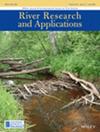检测河川灾害的随机森林机器学习模型
IF 1.9
4区 环境科学与生态学
Q4 ENVIRONMENTAL SCIENCES
引用次数: 0
摘要
河流的流动性和洪水等冲积灾害通常会给道路基础设施带来问题,需要在规划过程中加以考虑。由于河流和道路基础设施网络的范围及其相互靠近的趋势,因此需要能够快速、经济高效地识别最危险的区域。在本研究中,我们提出了一种使用随机森林(RF)机器学习方法的新方法,可为大型河流系统提供易于解释的精细尺度河流灾害预测。所开发的工具可在加拿大魁北克省内三个流域的河道网络中每隔 100 米的参考点提供三种模型的预测:洪水存在(PFM)、流动性存在(PMM)和侵蚀模型类型(TEM、横向迁移或切入)。RF 模型使用的变量侧重于河流条件和水文地质过程,如封闭性、蜿蜒度和上游坡度。培训/验证数据包括实地观测结果、水力和侵蚀模型结果、政府基础设施数据库以及使用 1 米 DEM 和卫星/历史图像进行的水文地质评估。在 1145 公里河流的 11,452 个参考点中,共有 1807 个参考点进行了洪水分类,1542 个参考点进行了流动性分类,847 个参考点进行了侵蚀类型分类。这些数据分为训练数据集(75%)和验证数据集(25%),其中训练数据集用于训练有监督的射频模型。验证数据集表明,这些模型能够准确预测可能发生的河流灾害,三个模型的精确度结果为 83% 到 94% 的预测点。这项研究的结果表明,射频模型是一种经济有效的工具,可用于快速评估流域范围内发生流体灾害的可能性。本文章由计算机程序翻译,如有差异,请以英文原文为准。
A random forest machine learning model to detect fluvial hazards
Fluvial hazards of river mobility and flooding are often problematic for road infrastructure and need to be considered in the planning process. The extent of river and road infrastructure networks and their tendency to be close to each other creates a need to be able to identify the most dangerous areas quickly and cost‐effectively. In this study, we propose a novel methodology using random forest (RF) machine learning methods to provide easily interpretable fine‐scale fluvial hazard predictions for large river systems. The tools developed provide predictions for three models: presence of flooding (PFM), presence of mobility (PMM) and type of erosion model (TEM, lateral migration, or incision) at reference points every 100 m along the fluvial network of three watersheds within the province of Quebec, Canada. The RF models use variables focused on river conditions and hydrogeomorphological processes such as confinement, sinuosity, and upstream slope. Training/validation data included field observations, results from hydraulic and erosion models, government infrastructure databases, and hydro‐ geomorphological assessments using 1‐m DEM and satellite/historical imagery. A total of 1807 reference points were classified for flooding, 1542 for mobility, and 847 for the type of erosion out of the 11,452 reference points for the 1145 km of rivers included in the study. These were divided into training (75%) and validation (25%) datasets, with the training dataset used to train supervised RF models. The validation dataset indicated the models were capable of accurately predicting the potential for fluvial hazards to occur, with precision results for the three models ranging from 83% to 94% of points accurately predicted. The results of this study suggest that RF models are a cost‐effective tool to quickly evaluate the potential for fluvial hazards to occur at the watershed scale.
求助全文
通过发布文献求助,成功后即可免费获取论文全文。
去求助
来源期刊

River Research and Applications
环境科学-环境科学
CiteScore
4.60
自引率
9.10%
发文量
158
审稿时长
6 months
期刊介绍:
River Research and Applications , previously published as Regulated Rivers: Research and Management (1987-2001), is an international journal dedicated to the promotion of basic and applied scientific research on rivers. The journal publishes original scientific and technical papers on biological, ecological, geomorphological, hydrological, engineering and geographical aspects related to rivers in both the developed and developing world. Papers showing how basic studies and new science can be of use in applied problems associated with river management, regulation and restoration are encouraged as is interdisciplinary research concerned directly or indirectly with river management problems.
 求助内容:
求助内容: 应助结果提醒方式:
应助结果提醒方式:


